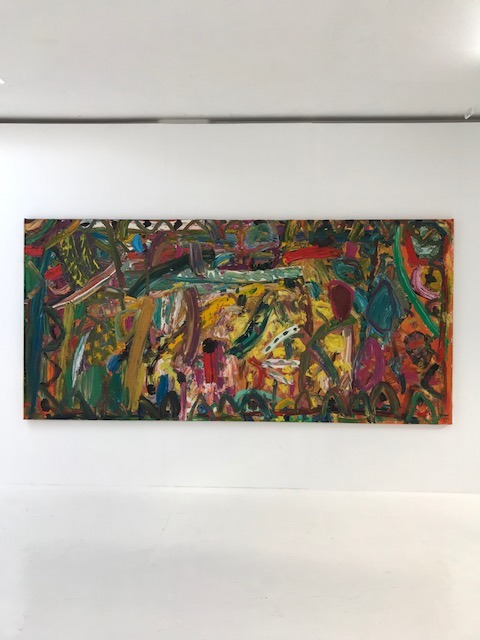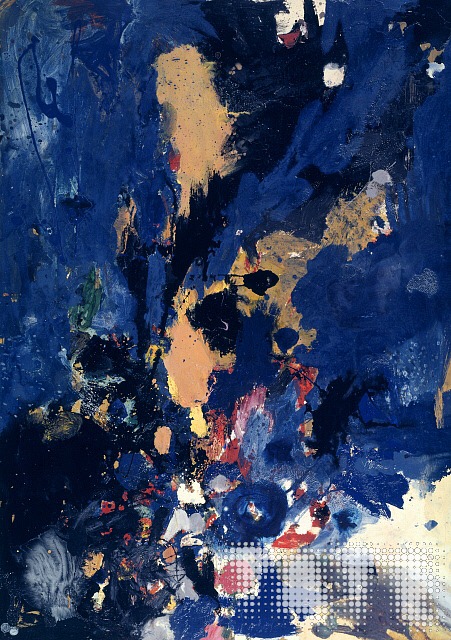Gillian Ayres – B: 3 Feb 1930 – D:11 April 2018
Painting details – ‘The dance of the Ludi Magni’- 1984. Oil on canvas. 167 x 345 cm
Images; My own
‘The dance of the Ludi Magni’ was exhibited as a part of the painting exhibition ’Bad Actors in September 2019 at Karst Plymouth. The exhibition takes its cue from Pirandello’s play ‘Six Characters in Search of an Author’ and a particular scene which calls into question the nature of reality.
The first thing I noticed on entering the gallery space was the aesthetic of the work in the space as a whole. This impact primarily due to the use of bright colour, in addition three of the works were draped and suspended around the gallery in a non traditional way giving the collective work an immersive feeling and a subtle sense of a studio setting rather than that of a gallery. It appeared that some of the work had an unfinished quality lying bare the canvas or gesso beneath the surface. For me this allowed insight into the act of painting and less the narrative or artist’s intention.
‘The dance of the Ludi Magni’by Gillian Ayres is a large scale oil on a deep unframed raw canvas. The Catalogue entry reads: Gillian Ayres’s work underwent a change in direction as she consolidated her late style: a richly allusive and expressive abstraction in high keyed colour. Karst (2019) The painting exhibited is exemplary of this change in Ayres work of the early eighties onward displaying visceral impasto and gestural mark making.
At first the colour is the feature which dominates; there is what seems like a chaotic application of pigment which seems to follow no rules of composition or order. Clashing umbers and bright pinkish crimsons smeared against what appears to be carelessly applied yellows amongst many others. This striking impasto is sculptural and appears heavy, lumpy and loosely applied. There is a sense of the artists hand which overpowers and tracks the duration of the making process and movements.
The painting seems chaotic but there is a roughly rectangular yellow ground to the upper centre which seems to literally sets out a stage for the focal point of the painting. This focus brings order to the painting briefly and then the eye diverts tracking over the colourful random forms across the canvas. There is a roughly rendered and overpainted border which runs around the edge of the canvas broken by the overlap of the main painting – evidence of the sequence of order in the making process.
It seems that the work is about colour and application made with a love of materials specifically oils and a story is told through the tell tale fingerprints, scratches and brushstrokes. At first inspection it looks although the paint has been applied in a rushed chaotic thrust of the paint on canvas. In a 1988 Geoffrey Robinson film a 58 year old Ayres talks about her practice whilst painting. In the film Ayres does not rush but carefully climbs a ladder to apply paint with her hands or large brushes. She talks about standing back and painting as a whole as opposed to working areas separately stating ‘It has to work as whole sometimes sacrificing well rendered areas’. There seems no reason for the particularly placed paint as far as composition or representation is concerned it is all down to Ayres response to the marks that have been placed already.
Ayres was 84 when she painted ‘The dance of the Ludi Magni’, at this time she was unable to throw herself physically into her work as she once had in her earlier works where she had worked on the floor inspired by Pollock, using paint in a more fluid form, splashing ,dripping and dragging whist knelt on the canvas. Her later work relied more heavily on undiluted pigments applied using her hands, fingers and brushes as opposed to relying on bodily actions such as lunging , stretching and throwing of liquid pigment seen in her early pieces. An earlier piece can be seen below was painted using household paint dissolved in solvent working at pace spontaneously. Her main concerns at this time were space (surface), materials and colour, and balancing these ‘so that nothing is more important than anything else. One was into the idea of no composition…’ (‘Distillation’, Gillian Ayres OBE, 1957 | Tate, 2019) Although changes are evident in Ayres painting practice as time passed such as line and form, the similarities are evident in the application of medium and colour with less focus on composition.

Distillation – Gillian Ayres
1957
Oil paint and household paint on hardboard Dimensions: support: 2134 x 1524 mm (Tate, 2020)



Recent Comments